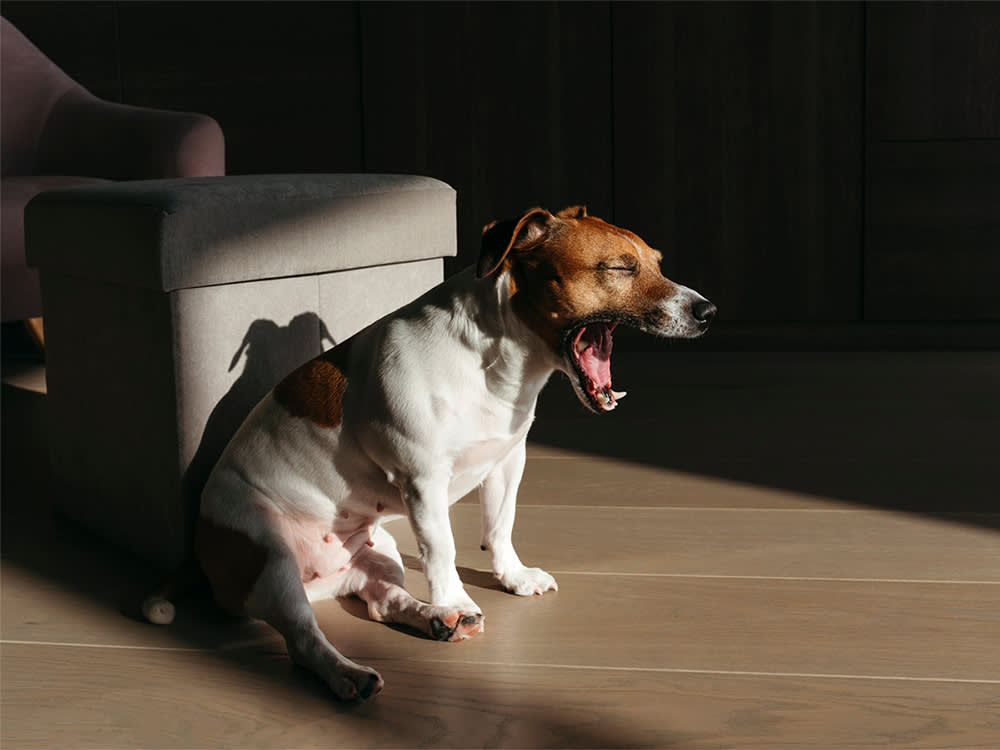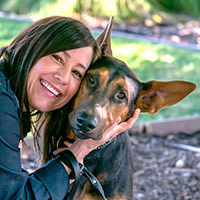How to Help a Choking Dog and Prevent Choking in the First Place
Learn about the causes and what to do for a choking dog

share article
New fear unlocked: having to give the Heimlich manoeuvre to a choking dog. Yes, that’s a real thing and it’s only one of several strategies to use if your dog has gulped down one weird thing too many. Even scarier than squeezing a dog until it throws up is not knowing how – pet parents frequently report their dog has got “something stuck in the throat” due to their curious nature and indiscriminate eating habits. They’ll hoover up anything, including food and objects.
That may end up in a different trip to the hospital if their tennis ball makes it down to the tummy, but if your pet is gasping for air right in front of you, you’re now the doctor. Here’s what to know about choking dogs and what you can do for them.
Common causes of choking in dogs
A common veterinary emergency, choking means that there is an interference of a dog’s breathing and usually occurs when there’s an obstruction of the airway from a foreign object in the throat. It can also be caused by severe swelling of the throat, constriction of the neck, or compression on the dog’s trachea, or windpipe.
If you observe any of the above signs of choking in your dog, seek veterinary care immediately. The most common signs that your pet is potentially choking include:
drooling
gagging
difficulty swallowing
difficulty breathing
pawing at face
regurgitation
anxiety
distress
They ate something they shouldn’t have
A ‘foreign object’ such as a toy, sock, stick or anything really that your dog attempts to eat could cause them to choke. The object can cause choking in a dog either directly, meaning actually in the airway, or indirectly, meaning it’s compressing on the airway. A dog can manage to swallow something without it necessarily being ‘stuck’, but it compresses the trachea, making breathing difficult.
Choking due to allergic reaction
Severe throat swelling can also cause choking and is usually associated with an allergic reaction or response to trauma like a snake bite. The tissues within the throat can swell and block the opening to the airway.
They could be choking due to neck constriction
Constricting neck injuries are usually associated with a dog’s collars and leads. Dogs whose collars become tangled or snagged can choke due to the constriction of the neck from the tightness of the collar. In sad and severe cases, dogs can even hang themselves from collars, leashes and ropes – potentially leading to death. Please take this moment to check your pets’ collars and ensure that they are the proper size. Extra precaution here can prevent a devastating situation.
What to do if your dog is choking
Immediate vet care isn’t always an option, even if it’s the recommended thing to do. If you notice that your dog is choking, the following measures may buy you some time while you are arranging for medical attention.
First, check for the obstruction
Remove any item that may be constricting the neck, like a tight collar. If you can do it safely, examine the inside of the mouth and remove any foreign object you can see, but do not attempt to remove an object unless you can see and identify it easily.
If you cannot easily remove the object, lift and suspend a small animal with the head pointed down. For larger animals, lift the rear legs so the head is tilted down, like a wheelbarrow. This can help dislodge an item stuck in the throat. Another method is to administer a sharp hit with the palm of your hand between the shoulder blades, which can sometimes dislodge an object.
Second, use the Heimlich manoeuvre
Finally, learn to use the modified Heimlich manoeuvre for dogs. Grasp the animal around the waist so that the rear is nearest to you, similar to a bear hug. Place a fist just behind the ribs. Compress the belly three to five times with quick pushes. Check the mouth to see if the foreign object has been dislodged.
What to do if your pet is unconscious
If your dog is unconscious, perform a finger sweep by opening your dog’s mouth and placing your finger along the inside of the mouth, sliding it down towards the centre of the throat over the base of the tongue, and gently ‘sweeping’ towards the centre to remove any foreign material.
Warning: there is a structure deep in the throat, the Adam’s apple, that feels like a smooth bone. Do not attempt to pull it out!
Conditions that are often mistaken for choking
More times than not, what people believe to be their dog choking, is actually an attempt to vomit or cough, or simply a reverse sneezeopens in a new tab. Many dog parents will seek vet care because they believe their dog has something stuck in its throat, however, it is far more likely that your pet has something mild and infectious, such as tracheobronchitis, also known as kennel coughopens in a new tab, and they are coughingopens in a new tab rather than choking.
With choking, the pet has difficulty inhaling; with coughing, the pet can inhale almost normally.
How to avoid any of this
The best treatment for choking is definitely prevention. There are things you can do to protect your dog from these issues.
Start by making sure your dog has a collar that fits properly. Dog collars that are too tight or too loose can create serious injury and possibly death. If you use a rope tethered to the ground outside (or a ‘tie out’), don‘t allow your dog to have too much slack that it allows jumping over fences or off raised decks and patios.
Like with human children, keep all choking hazards, such as small items and toys, away from your dog. Choose safe dog toys for your dog’s size and breed – super balls and mini tennis balls for smaller breed dogs are also a common cause of upper airway obstruction in large breed dogs. Think about how you wouldn’t leave a baby alone with a stack of pennies. Assume your dog will make the same choices as a baby, but much faster, and keep them safe by being the grown-up.

Dr. Shea Cox, DVM, CVPP, CHPV
Dr. Shea Cox is the founder of BluePearl Pet Hospice and is a global leader in animal hospice and palliative care. With a focus on technology, innovation and education, her efforts are changing the end-of-life landscape in veterinary medicine.
Related articles
![Man crouching down to let two dogs eat out of a bowl]() opens in a new tab
opens in a new tabHow Many Treats Is Too Many?
The key to curbing mindless snacking – according to a veterinarian
![Woman comforting her Corgi]() opens in a new tab
opens in a new tabTricks to Get Your Pup to Swallow a Pill
Five vet-approved techniques to make tablets go down easy
![Side view of a cute hungry dog standing next to a red bowl with food in a studio with white background]() opens in a new tab
opens in a new tabHow to Get a Dog to Eat
You can’t appease a picky dog with chicken nuggets like you can with a toddler. Here are some things you can do
![Avoid heat stroke in dogs by sprinkling in the backyard with your dog]() opens in a new tab
opens in a new tabHeat–Stroke in Dogs: Signs, Treatment & Prevention Expert Advice
How to take precautions for your pup when temperatures rise





